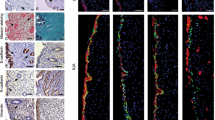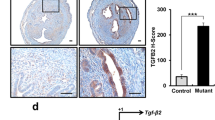Abstract
The Wnt/β-catenin signaling is essential for various organogenesis and is often implicated during tumorigenesis. Dysregulated β-catenin signaling is associated with the formation of endometrial adenocarcinomas (EACs), which is considered as the common form of endometrial cancer in women. In the current study, we investigate the downstream target of Wnt/β-catenin signaling in the uterine epithelia and the mechanism leading to the formation of endometrial hyperplasia. We report that conditional ablation and activation of β-catenin in the uterine epithelia lead to aberrant epithelial structures and endometrial hyperplasia formation, respectively. We demonstrate that β-catenin regulates Foxa2 with its candidate upstream region for the uterine epithelia. Furthermore, knockdown of Foxa2 leads to defects in cell cycle regulation, suggesting a possible function of Foxa2 in the control of cell proliferation. We also observe that β-catenin and Foxa2 expression levels are augmented in the human specimens of complex atypical endometrial hyperplasia, which is considered to have a greater risk of progression to EACs. Thus, our study indicates that β-catenin regulates Foxa2 expression, and this interaction is possibly essential to control cell cycle progression during endometrial hyperplasia formation. Altogether, the augmented expression levels of β-catenin and Foxa2 are essential features during the formation of endometrial hyperplasia.
This is a preview of subscription content, access via your institution
Access options
Subscribe to this journal
Receive 50 print issues and online access
$259.00 per year
only $5.18 per issue
Buy this article
- Purchase on Springer Link
- Instant access to full article PDF
Prices may be subject to local taxes which are calculated during checkout




Similar content being viewed by others
References
Kawano Y, Kitaoka M, Hamada Y, Walker MM, Waxman J, Kypta RM . Regulation of prostate cell growth and morphogenesis by Dickkopf-3. Oncogene 2006; 25: 6528–6537.
Grigoryan T, Wend P, Klaus A, Birchmeier W . Deciphering the function of canonical Wnt signals in development and disease: conditional loss- and gain-of-function mutations of beta-catenin in mice. Genes Dev 2008; 22: 2308–2341.
Kobayashi A, Behringer RR . Developmental genetics of the female reproductive tract in mammals. Nat rev 2003; 4: 969–980.
Perantoni AO . Renal development: perspectives on a Wnt-dependent process. Semin Cell Dev Biol 2003; 14: 201–208.
Hayashi K, Spencer TE . WNT pathways in the neonatal ovine uterus: potential specification of endometrial gland morphogenesis by SFRP2. Biol Reprod 2006; 74: 721–733.
Yu X, Wang Y, DeGraff DJ, Wills ML, Matusik RJ . Wnt/beta-catenin activation promotes prostate tumor progression in a mouse model. Oncogene 2011; 30: 1868–1879.
Nei H, Saito T, Yamasaki H, Mizumoto H, Ito E, Kudo R . Nuclear localization of beta-catenin in normal and carcinogenic endometrium. Mol Carcinog 1999; 25: 207–218.
Jeong JW, Lee HS, Franco HL, Broaddus RR, Taketo MM, Tsai SY et al. beta-catenin mediates glandular formation and dysregulation of beta-catenin induces hyperplasia formation in the murine uterus. Oncogene 2009; 28: 31–40.
Scholten AN, Creutzberg CL, van den Broek LJ, Noordijk EM, Smit VT . Nuclear beta-catenin is a molecular feature of type I endometrial carcinoma. J Pathol 2003; 201: 460–465.
Zhu H, Mazor M, Kawano Y, Walker MM, Leung HY, Armstrong K et al. Analysis of Wnt gene expression in prostate cancer: mutual inhibition by WNT11 and the androgen receptor. Cancer Res 2004; 64: 7918–7926.
Sasaki H, Hogan BL . Enhancer analysis of the mouse HNF-3 beta gene: regulatory elements for node/notochord and floor plate are independent and consist of multiple sub-elements. Genes Cells 1996; 1: 59–72.
Cirillo LA, Lin FR, Cuesta I, Friedman D, Jarnik M, Zaret KS . Opening of compacted chromatin by early developmental transcription factors HNF3 (FoxA) and GATA-4. Mol Cell 2002; 9: 279–289.
Kaestner KH . The FoxA factors in organogenesis and differentiation. Curr Opin Genet Dev 2010; 20: 527–532.
Williamson EA, Wolf I, O’Kelly J, Bose S, Tanosaki S, Koeffler HP . BRCA1 and FOXA1 proteins coregulate the expression of the cell cycle-dependent kinase inhibitor p27(Kip1). Oncogene 2006; 25: 1391–1399.
Ojalvo LS, Whittaker CA, Condeelis JS, Pollard JW . Gene expression analysis of macrophages that facilitate tumor invasion supports a role for Wnt-signaling in mediating their activity in primary mammary tumors. J Immunol 2010; 184: 702–712.
Suzuki K, Yamaguchi Y, Villacorte M, Mihara K, Akiyama M, Shimizu H et al. Embryonic hair follicle fate change by augmented beta-catenin through Shh and Bmp signaling. Development 2009; 136: 367–372.
Tarutani M, Itami S, Okabe M, Ikawa M, Tezuka T, Yoshikawa K et al. Tissue-specific knockout of the mouse Pig-a gene reveals important roles for GPI-anchored proteins in skin development. Proc Natl Acad Sci USA 1997; 94: 7400–7405.
Cunha GR . Epithelial-stromal interactions in development of the urogenital tract. Int Rev Cytol 1976; 47: 137–194.
Cunha GR . Stromal induction and specification of morphogenesis and cytodifferentiation of the epithelia of the Mullerian ducts and urogenital sinus during development of the uterus and vagina in mice. J Exp Zool 1976; 196: 361–370.
Kurita T, Cooke PS, Cunha GR . Epithelial-stromal tissue interaction in paramesonephric (Mullerian) epithelial differentiation. Dev Biol 2001; 240: 194–211.
Matias-Guiu X, Catasus L, Bussaglia E, Lagarda H, Garcia A, Pons C et al. Molecular pathology of endometrial hyperplasia and carcinoma. Hum Pathol 2001; 32: 569–577.
Berchuck A, Boyd J . Molecular basis of endometrial cancer. Cancer 1995; 76: 2034–2040.
Wang Y, Hanifi-Moghaddam P, Hanekamp EE, Kloosterboer HJ, Franken P, Veldscholte J et al. Progesterone inhibition of Wnt/beta-catenin signaling in normal endometrium and endometrial cancer. Clin Cancer Res 2009; 15: 5784–5793.
Huang WW, Yin Y, Bi Q, Chiang TC, Garner N, Vuoristo J et al. Developmental diethylstilbestrol exposure alters genetic pathways of uterine cytodifferentiation. Mol endocrinol 2005; 19: 669–682.
Armaiz-Pena GN, Mangala LS, Spannuth WA, Lin YG, Jennings NB, Nick AM et al. Estrous cycle modulates ovarian carcinoma growth. Clin Cancer Res 2009; 15: 2971–2978.
Daikoku T, Jackson L, Besnard V, Whitsett J, Ellenson LH, Dey SK . Cell-specific conditional deletion of Pten in the uterus results in differential phenotypes. Gynecol Oncol 2011; 122: 424–429.
Daikoku T, Dey SK . Two faces of PTEN. Nat Med 2008; 14: 1192–1193.
Daikoku T, Hirota Y, Tranguch S, Joshi AR, DeMayo FJ, Lydon JP et al. Conditional loss of uterine Pten unfailingly and rapidly induces endometrial cancer in mice. Cancer Res 2008; 68: 5619–5627.
Fyles A, Wood G, Li M, Manoukian AS, Gowing K, Khokha R et al. Neither ovariectomy nor progestin treatment prevents endometrial neoplasia in pten+/− mice. Gynecol Oncol 2008; 108: 395–401.
Jeong JW, Kwak I, Lee KY, Kim TH, Large MJ, Stewart CL et al. Foxa2 is essential for mouse endometrial gland development and fertility. Biol Reprod 2011; 83: 396–403.
Siepel A, Bejerano G, Pedersen JS, Hinrichs AS, Hou M, Rosenbloom K et al. Evolutionarily conserved elements in vertebrate, insect, worm, and yeast genomes. Genome Res 2005; 15: 1034–1050.
Giannini A, Mazor M, Orme M, Vivanco M, Waxman J, Kypta R . Nuclear export of alpha-catenin: overlap between nuclear export signal sequences and the beta-catenin binding site. Exp Cell Res 2004; 295: 150–160.
Mo B, Vendrov AE, Palomino WA, DuPont BR, Apparao KB, Lessey BA . ECC-1 cells: a well-differentiated steroid-responsive endometrial cell line with characteristics of luminal epithelium. Biol Reprod 2006; 75: 387–394.
Fujita PA, Rhead B, Zweig AS, Hinrichs AS, Karolchik D, Cline MS et al. The UCSC Genome browser database: update 2011. Nucleic acids res 2011; 39: D876–D882.
Yue X, Lan F, Yang W, Yang Y, Han L, Zhang A et al. Interruption of beta-catenin suppresses the EGFR pathway by blocking multiple oncogenic targets in human glioma cells. Brain Res 2010; 1366: 27–37.
Eeckhoute J, Carroll JS, Geistlinger TR, Torres-Arzayus MI, Brown M . A cell-type-specific transcriptional network required for estrogen regulation of cyclin D1 and cell cycle progression in breast cancer. Genes Dev 2006; 20: 2513–2526.
Hanazono M, Tomisawa H, Tomooka Y, Hirabayashi K, Aizawa S . Establishment of uterine cell lines from p53-deficient mice. In Vitro Cell Dev Biol Anim 1997; 33: 668–671.
Guzzo F, Bellone S, Buza N, Hui P, Carrara L, Varughese J et al. HER2/neu as a potential target for immunotherapy in gynecologic carcinosarcomas. Int J Gynecol Pathol 2012; 31: 211–221.
Rhodes DR, Kalyana-Sundaram S, Mahavisno V, Barrette TR, Ghosh D, Chinnaiyan AM . Mining for regulatory programs in the cancer transcriptome. Nat Genet 2005; 37: 579–583.
Yang W, Xia Y, Ji H, Zheng Y, Liang J, Huang W et al. Nuclear PKM2 regulates beta-catenin transactivation upon EGFR activation. Nature 2011; 480: 118–122.
Silverberg SG . Molecular diagnosis and prognosis in gynecologic oncology. Arch Pathol Lab Med 1999; 123: 1035–1040.
Behrens J, von Kries JP, Kuhl M, Bruhn L, Wedlich D, Grosschedl R et al. Functional interaction of beta-catenin with the transcription factor LEF-1. Nature 1996; 382: 638–642.
Acknowledgements
We thank Drs R Behringer, H Sasaki, M M Taketo, W Birchmeier, A Santin, R Nishinakamura, Y Yoshimura, T Kurita, N Shiraki, K Maehara, H Nishida-Fukuda, K Yoshinaga, MA Suico, S Ohta, A Murashima, L Liu, A Omori, M Harada and D Matsumaru for their constructive criticisms We also thank E Chun, Y Sakamoto, Y Yamakawa, T Seki, M Aoki, S Usuki, M Matsumuto, M Etoh, S Fujikawa, Y Endo, S Miyaji and T Iba for technical help. This work was supported by Grant-in-Aid for Scientific Research on Innovative Areas: molecular mechanisms for the establishment of Sex Differences (22132006), Global Center of Excellence program ‘Cell Fate Regulation Research and Education Unit’ and Grant-in-Aid for Young Scientists (B) from the Ministry of Education, Culture, Sports, Science and Technology (MEXT), Japan. This work was also supported by the National Institutes Health grant R01ES016597-01A1.
Author information
Authors and Affiliations
Corresponding author
Ethics declarations
Competing interests
The authors declare no conflict of interest.
Additional information
Supplementary Information accompanies the paper on the Oncogene website
Supplementary information
Rights and permissions
About this article
Cite this article
Villacorte, M., Suzuki, K., Hirasawa, A. et al. β-Catenin signaling regulates Foxa2 expression during endometrial hyperplasia formation. Oncogene 32, 3477–3482 (2013). https://doi.org/10.1038/onc.2012.376
Received:
Revised:
Accepted:
Published:
Issue Date:
DOI: https://doi.org/10.1038/onc.2012.376
Keywords
This article is cited by
-
Uterine glands coordinate on-time embryo implantation and impact endometrial decidualization for pregnancy success
Nature Communications (2018)



